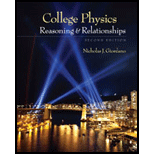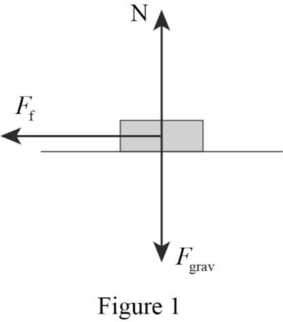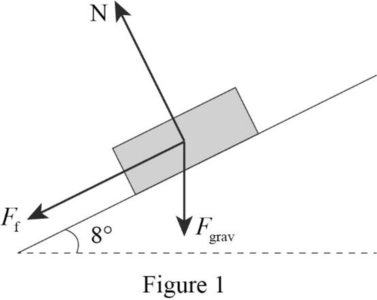
Concept explainers
The stopping distance of the car measured along the incline.
Answer to Problem 45P
The stopping distance of the car measured along the incline is
Explanation of Solution
Figure 1 represents the free body diagram of car on level ground.

Figure 1 represents the free body diagram of car on the incline .

Write the
Here,
Write the expression for net force acting on the car.
Here,
Write the expression for kinetic friction force.
Here,
The above equation can be written as
The net force acting on the level car is opposite to the friction force.
Rearrange the above equation.
Since the car on the level ground is at rest, equation (I) is written as
Use the above equation in equation (IV).
Write the acceleration of the object down an incline from equation.
Here,
Use the above equation in equation (V).
Write the kinematic equation of the car in inclined motion.
Here,
Since the final velocity of the car in inclined motion is zero, the above equation is written as
Conclusion:
Substitute
Substitute
Therefore, the stopping distance of the car measured along the incline is
Want to see more full solutions like this?
Chapter 4 Solutions
College Physics
- A celebrated Mark Twain story has motivated contestants in the Calaveras County Jumping Frog Jubilee, where frog jumps as long as 2.20 m have been recorded. If a frog jumps 2.20 m and the launch angle is 50.0°, find the frog's launch speed and the time the frog spends in the air. Ignore air resistance.(a)the frog's launch speed (in m/s) m/s(b)the time the frog spends in the air (in s) sarrow_forwardA train makes a round trip on a straight, level track. The first half of the trip is 300\ \mathrm{km}300 km and is traveled at a speed of 75\ \mathrm{km/ h}75 km/h. After a 0.50\ \mathrm{h}0.50 h layover , the train returns the 300\ \mathrm{km}300 km at a speed of 85\ \mathrm{km/ h}85 km/h. What is the train's (a) average speed and (b) average velocity?arrow_forwardAn object is thrown upwards from the ground level at a speed of 58m/s. It travels upwards to the highest point of its path and then falls back to the ground. What is the objects speed and direction right as it is about to hit the ground at the end of it's fall? * 24 m/s upwards 24 m/s downwards 0 m/s upwards 9.8 m/s upwards 9.8 m/s downwards 58 m/s upwards 58 m/s downwardsarrow_forward
- An elevator in a high-rise building goes up and down at the same speed. Starting at the ground floor, Rafael and Monica ride up five floors. The elevator stops for 10 s as Monica gets off. Rafael then goes back down two floors in 2s. Rafael’s entire trip takes 24 s. Each floor is 20m. For Rafael’s trip, determine the (a) total distance in (m) (b) total displacement in (m) (c) Average speed in (m/s) (d) Average velocity in (m/s)arrow_forwardA long jumper leaves the ground at an angle of 60.0° above the horizontal and at a speed of 8.0 m/s. What is the maximum height reached? 1.06m 0.86m 0.92m 1.60marrow_forwardA stone was thrown downward from atop a building 50 m high with an angle of - 60 degrees and with an initial velocity of 6 m/s. How far from the side of the building will the stone land? a. 5.196 m b. 8.12 m c. 1.353 m d. 3 marrow_forward
- A rescue helicopter is hovering over a person whose sailboat has capsized. One of the rescuers tosses a life preserver straight down to the person with an initial speed of 1.25 m/s and observes that it takes 1.75 s to reach the water. How high above the water was the preserver released? Note that the downdraft of the helicopter reduces the effect of air resistance on the falling life preserver, so that an acceleration equal to that due to gravity is reasonable.arrow_forwardAn object is thrown with a horizontal velocity of 20 m/s from a cliff that is 125 m above level ground. If air resistance is negligible, the time that it takes the object to fall to the ground from the cliff is most nearly a 12 s b 3 s c 6 s d 25 s e 5 sarrow_forwardAn AUS student drives from home to attend her 9 am class. She drives east for 15 minutes at 80 km/h and noted that she had a flat tire. She stops for 45 minutes replacing the flat tire with the spare tire. She then continues her journey eastward traveling another 37 km for 18 minutes to reach the campus. Her average velocity during the entire period is approximatly. a ) 64 km/h b ) 44 km/h c ) 39 km/h d) 6 km/harrow_forward
- A rock is thrown straight down from the Verrazano Narrows Bridge in New York City with an initial speed of 13.5 m/s. The roadway of this bridge is 70 m above the water. Take upwards to be the positive direction. a)Calculate the displacement at the time of 1.0 s. b) Calculate the velocity at the time of 1.0 s. c) Calculate the displacement at the time of 1.5 s. d) Calculate the velocity at the time of 1.5 s. e) Calculate the displacement at the time of 2.0 s. f) Calculate the velocity at the time of 2 s. g) Calculate the displacement at the time of 2.5 s. h)Calculate the velocity at the time of 2.5 s.arrow_forwardIf a rock is thrown with an initial velocity of 5.4 m/s in the y-direction and 8.2 m/s in the x-direction. At what angle was the rock thrown?arrow_forwardSalmon often jump waterfalls to reach their breeding grounds. Starting downstream, 1.81 m away from a waterfall 0.347 m in height, at what minimum speed must a salmon jumping at an angle of 40 ◦ leave the water to continue upstream? The acceleration due to gravity is 9.81 m/s 2 . Answer in units of m/s.arrow_forward
 Principles of Physics: A Calculus-Based TextPhysicsISBN:9781133104261Author:Raymond A. Serway, John W. JewettPublisher:Cengage Learning
Principles of Physics: A Calculus-Based TextPhysicsISBN:9781133104261Author:Raymond A. Serway, John W. JewettPublisher:Cengage Learning
